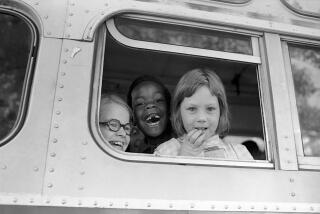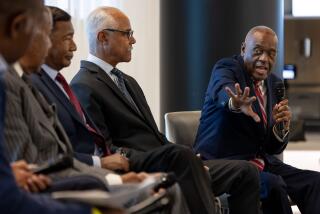Chronicling the Quiet Desegregation of Houston
- Share via
Scenes of rapacious police dogs and blasting fire hoses dominate the media images of America’s civil-rights movement. But desegregation came to some Southern cities stealthily and without violence, a little-known fact brought to light in a new documentary airing Thursday on KOCE-TV.
“This was the most important story that [then-Houston newsman] Dan Rather never covered,” said historian Thomas R. Cole, creator of “The Strange Demise of Jim Crow,” to be aired in honor of Black History Month.
Through interviews and vintage footage, the hourlong program examines how Texas Southern University students staged sit-ins while black businessmen and community leaders negotiated behind-the-scenes with their white counterparts to peacefully integrate “whites only” lunch counters, movies and hotels in Houston, home of the South’s largest black community.
Based on Cole’s 1997 book, “No Color Is My Kind: The Life of Eldrewey Stearns and the Integration of Houston,” the film spotlights the leader of the TSU movement.
Cole, a professor of medical humanities at the University of Texas, Galveston, met Stearns while working in a Texas psychiatric hospital in 1984.
Manic-depression dragged Stearns down in his early 30s, Cole said in a recent phone interview, but not before he earned a TSU law degree and organized the first sit-in west of the Mississippi. On March 4, 1960, Stearns and fellow protesters targeted an all-white lunch counter at Weingarten’s supermarket, then repeated the action at Madey’s Drugs.
Up in arms, politicians threatened the students with arrest, but black leaders had quietly begun closed-door meetings with the white establishment, which feared that civil strife would be bad for the city’s image.
“The blacks were playing the students off against the whites,” Cole said, “encouraging them to continue the pressure, but saying to the whites, ‘Let’s see if we can sit down and talk this out.’ ”
In a historical turning point, which came after protesters boycotted Foley’s department store, the store’s marketing chief devised a plan. To stem opposition from segregationists, Bob Dundas would ask all of downtown’s businesses to integrate simultaneously.
Dundas promised business owners that the event wouldn’t make the news, and the local print and broadcast media agreed to a weeklong blackout because Dundas threatened to pull Foley’s advertising, Cole said.
Some newspaper publishers and others screamed censorship, but they also feared a race riot.
Six months after the students’ first sit-in, 70 Houston lunch counters had been desegregated, the documentary reports. And with continuing secret negotiations and a second news blackout, the city’s hotels admitted blacks. However, as civil unrest escalated throughout the South, TSU students’ outrage over the news ban mushroomed.
Their anger peaked in May 1963 on the eve of a downtown parade to celebrate the last of Houston-based NASA’s Mercury missions. The students plotted to block the internationally televised parade.
But Stearns stopped them when black negotiators told him that white leaders had agreed to integrate movie theaters and restaurants if the protest was squashed, Cole said.
“He was under lots of pressure to make a scene and embarrass Houston internationally,” Cole said. “The militant students called him an Uncle Tom. But he had the sense to understand that they were achieving their goals.”
Stearns’ mental health began to unravel after the parade, Cole said, and he spent the next two decades cycling in and out of hospitals or homelessness. Cole helped Stearns get disability benefits, but the historian had to rely on others for much of the detail in his documentary, which premiered Feb. 2 on New Mexico and Texas public television.
“It’s a hopeful story and a cautionary tale,” he said. “People can negotiate differences if they work in good faith, and students can make a difference.”
* “The Strange Demise of Jim Crow” airs at 9 p.m. Thursday and 3 a.m. Friday on KOCE-TV.
More to Read
Sign up for Essential California
The most important California stories and recommendations in your inbox every morning.
You may occasionally receive promotional content from the Los Angeles Times.













